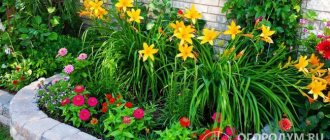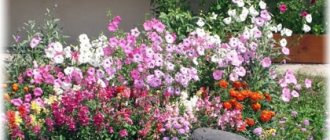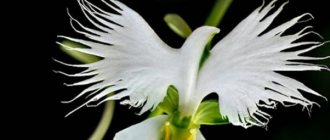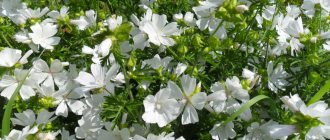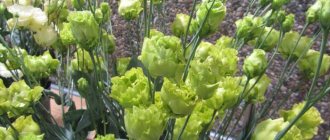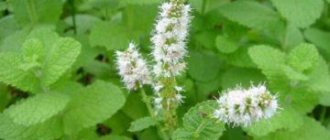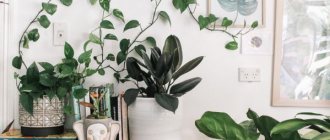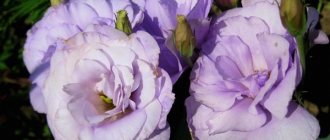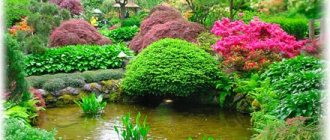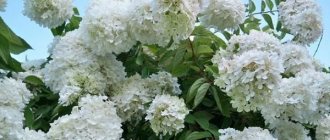Due to the diversity and wide range of shades, wild or meadow flowers are used in the design of Moorish lawns, garden plots and summer cottages. The plants are accustomed to wild conditions, so they are very unpretentious in care. This is another reason why they have earned the love of flower growers. In addition, they have healing properties and are used in cooking and cosmetology.
Names and brief descriptions of indoor flowers with purple leaves
The unusual color of the leaves can be of various shades: from light lilac to deep purple. It can be uniform, can be located on both sides of the leaf at once, and there are options where this color is presented on one side - only on the top or bottom, while the other part remains the usual green. Purple on both sides are the well-known wood sorrel (night butterfly) with small triangle leaves, irezine (which needs a large amount of light to maintain the brightness of the color). The types of Herbst irezine and Purple Lady irezine are monochromatic.
Stromanta as a flower garden decoration
The upper side of the leaves is purple
Among the whole variety of indoor flowers, painted in this unusual, unusual shade only on top, the most popular is hemigraphis alternating. There are more than 100 species of this plant in nature. At home, ampel and semi-ampel forms are grown. It can be perennial or annual. The plant is whimsical, but looks very impressive.
Oxalis oxalis
With proper care, the ovoid, serrated leaves turn purple on top (its saturation changes depending on the lighting), while remaining light green on the reverse side.
Hemigraphis alternating
The underside of the leaves is purple
There are other plants with leaves that are purple only on the bottom. The most common among them:
- reo is the most popular plant, whose lower part of the leaves is purple in color. It attracts flower growers with its unusual appearance and lack of pickiness in care. In addition, reo also blooms beautifully;
- ginura. There are several varieties, but the most popular and unpretentious is the variety Ginura braided. This is an ampelous species with velvety leaves. The leaves are shaped like nettles, but have an unusual color in the lower part;
Reo during the flowering period
- purpusa. This is a close relative of Tradescantia, and therefore caring for it is quite problematic. It is a long vine. The leaves are olive-reddish in color and slightly hairy on top, and smooth and deep purple below.
Note! All plants in this group may change color slightly depending on the lighting.
Conditions required for growing rheo
Lighting for Tradescantia capillata
Despite its pronounced color, it is Tradescantia tangulata that claims to be the most undemanding plant in terms of lighting. She does not like direct sunlight in the summer at noon, but during the rest of the year or morning and evening sun she adapts well. Any diffused lighting is suitable for this type of Tradescantia; it adapts perfectly to both bright light conditions and fairly moderate lighting.
In modern variegated varieties and the most brightly colored varieties of rheo, light dependence is more pronounced: in shading, plants partially or completely lose their characteristic color.
In rooms, it is better to place reo on window sills or at a small distance from them. Eastern, western and southern windows are suitable for Tradescantia capillata.
Comfortable temperature conditions
Reo is a heat-loving plant that is extremely sensitive to strong temperature changes. In room mode, it can only withstand cold temperatures down to 13 degrees Celsius. Plants growing in open soil are more hardy, but for indoor Tradescantia capillata it is better to control these indicators more carefully.
The plant tolerates any room temperature well; in summer, when it is hot, it is better to increase the air humidity. The optimal maintenance regime in spring and summer is at a temperature of about 20-23 degrees Celsius. In winter, it is not necessary to reduce the temperature for reo, the main thing is that they remain within 18-20 degrees.
It is not for nothing that Tradescantia is planted even in open soil as a summer plant. The plant loves fresh air; in the summer, reo can be transplanted into the soil or displayed in the garden. When growing indoors, you need to take care of regular ventilation.
At the same time, rheo does not like drafts, and even more so wind, when it is displayed in containers rather than buried in the soil, it is better to choose warm, protected areas. Reo also does not welcome sudden changes in temperature by more than 7-10 degrees.
Air humidity
The higher the air humidity, the more decorative colors and the beauty of greenery are revealed. Reo does not like dry air and stretches out, “aging” without additional measures much faster than when maintaining average values during the heating season or in the summer.
Tradescantia spathacea
Houseplants with purple spots or stripes on leaves
Home flower with maple-like leaves - striped abutilon
Indoor flowers that have a heterogeneous color look very impressive: with spots or stripes, a marble shade. The most attractive of them:
- royal begonia. This is one of the leafy begonia hybrids, grown not to admire the lush inflorescences, but to enjoy the foliage of an unusual, spotted color all year round. The leaf part has an asymmetrical shape and reaches a length of up to 15 cm. The pattern is always bright, representing a complex pattern of green, purple, silver and burgundy colors. Royal begonia is a very fastidious plant that needs extra attention;
Royal begonia
- Zebra Purpusa. One of five types of zebrina suitable for growing at home. The leaves are oval-shaped with pointed edges and a pronounced striped color. The colors of the stripes are white with lilac-burgundy, which looks very unusual and attractive. Blooms with small lavender flowers;
- irezine Linden. This is a plant whose leaves are dark purple on top, with reddish stripes and veins.
Iresine Lindena
Why is it important to be able to distinguish and choose correctly?
In order to choose the right variety to grow on your site, it is important to understand for what purpose it is needed . If for decoration and creating decor, then preference is given to compact varieties with beautiful shades. If this is a region with a cold climate, then in addition to the decorative appearance, you should also pay attention to the plant’s ability to tolerate frost.
When growing lavender for the purpose of obtaining medicinal raw materials, forming dry aromatic bouquets or sachets, then you need to opt for medicinal varieties with a rich aroma, as well as those that are able to retain their aroma and attractive appearance after drying.
House plants with purple flowers
Home maple abutilon - indoor flower
A purple home flower can delight not only with the color of its leaves, but also with its beautiful inflorescences. There are a lot of plants that bloom like this. The most popular among them are:
- Saintpaulia (Usambara violet). Violet is a name familiar to everyone; when you mention this word, you immediately think of a small plant with pubescent dark green leaves and medium-sized flowers. They have many species and hybrid varieties. In many types of violets, the flowers have a palette of colors from light lilac to deep purple; they can be simple or double;
- Gloxinia is an equally popular plant. Perennial, tuberous with original bell-shaped flowers. They are brightly colored inside, edged with a white stripe, and velvety to the touch;
- orchid. This plant is now at the peak of popularity. Large flowers of various shades are located on a tall thin trunk. The flowering period is long, the inflorescences are very elegant and unusual, similar to the wings of a butterfly. Lilac orchids are considered the most unpretentious and most resistant to disease.
Orchid flower
Clematis - the basis of a vertical composition
An indispensable attribute of a vertical garden are climbing plants, many of which boast purple flowers. Violet clematis and Jacquemin's clematis are characterized by abundant flowering. Such a purple hedge with light stripes that border clematis flowers will brightly decorate the garden, bringing it to life to the fullest. The clematis variety "Luther Burbank", planted on the outside of the garden composition and blooming with large purple flowers, will catch the admiring glance of more than one passerby.
The variety “Minister”, whose flowers are also decorated with a purple-violet stripe, can add a blue tint to the purple composition.
Indoor flowers with purple stems
What is the name of an indoor flower with red leaves?
Flowers grown on a windowsill very often have purple “trunks”. There are representatives of home flora that have such original stems:
- Setcreasia purpurea. It belongs to the Tradescantia family, so it requires a lot of attention. It is grown as an ampelous and semi-ampelous plant. It is distinguished not only by completely purple leaves, but also by stems of the same color, as well as lilac small flowers. The shoots are long, growing up to 1 m;
- tradescantia violet. An interesting plant with fleshy purple stems and leaves that accumulate moisture, reaching 20 cm in length. Blooms with small pink flowers. Growth form: semi-ampelous or bushy;
- Columnae Sulfurea is one of the varieties of Columnae (there are about 200 in total), which, like other representatives of this species, has only a hanging variant of growth. Lianas reach up to 1 m in length. All columnae need long daylight hours and bright lighting. These factors ensure their flowering and fruiting. Columnae Sulfurea flowers are tubular and yellow. After flowering, white fruits form on the plant. The stems of this flower are reddish-purple, as is the lower part of the leaf.
Columnea Sulfurea
Purple indoor flowers can decorate any room and bring a little variety to every interior. And it doesn’t matter at all whether it will be painted in this color in whole or in part. The most important thing is effectiveness and unusualness. As a rule, such plants are not too picky, and all they need is as much sunlight as possible to make the color brighter.
Features of caring for Tradescantia
Tradescantia, as an ampelous plant, is usually located in hanging pots. She sends her stems along the walls, decorating the room. Excess water after watering remains in the saucer or tray. After the procedure, approximately 30 minutes later, you need to drain the excess liquid.
Tradescantia hanging
Stagnation of water when growing hanging plants is dangerous. Therefore, it is necessary to use a thick drainage layer and be sure to water the flower after the soil dries.
For ease of humidification, it is better to purchase a watering can with a curved spout.
Even if it seems comfortable in the apartment, and the air is humid, it is worth remembering that the higher you go, the drier it is. Therefore, the plant, when it is located on the wall, may require additional spraying.
How to resuscitate?
Usually there are few problems with Tradescantia. For example, the plant calmly tolerates even short-term drought (a feature of the places from which Tradescantia spread).
Problems with appearance, if they arise, are usually manifested by nothing more than falling or withering leaves. In this case, they say that the plant either does not have enough lighting or is too hot in the room. Obviously, changing the location of the flower pot will help get rid of such problems.
On the other hand, softened and fleshy stems are the first sign of excessive soil moisture. If you leave everything as it is, you will soon see a rotting root system and the appearance of a black leg.
Feng Shui meaning
To achieve harmony and peace, as well as to increase positive energy in a room, according to the teachings of Feng Shui, which came from the East, a certain position of things and furniture, a certain arrangement of even flowers in pots is required
If a private yard is taken into account, then it is necessary to start work from the yard. You can compensate for the negative energy entering the house from the yard using indoor flowers
One of these flowers is Tradescantia capillata, or reo.
To normalize the energy at home, the flowers must be healthy and not show signs of wilting. Otherwise, the flowers emit the energy of death. It is necessary that they are suitable for this house and its owners - if they are not suitable, these flowers need to be given away.
Reo normalizes the energy field of people present in the house, removes aggression and tension in relationships, preserves the human biofield, and does not allow it to decrease.
According to the teachings of Feng Shui, there is a zone of love, children, career, health, and well-being in a room. In addition to being highlighted, the zones must be activated. But the interaction of zones and their mutual activation occurs through the work of a biofield of different colors located in the corresponding zone.
The balance of positive energy is maintained by the element to which this plant belongs. For example, Tradescantia reo keeps the zone of health and love balanced.
It is important to place the Tradescantia flower in the health zone:
- the plant improves the general health of the owner of the room;
- restores emotional balance;
- relieves irritation;
- normalizes blood flow and restores the functioning of the cardiovascular system;
- promotes recovery from any disease.
